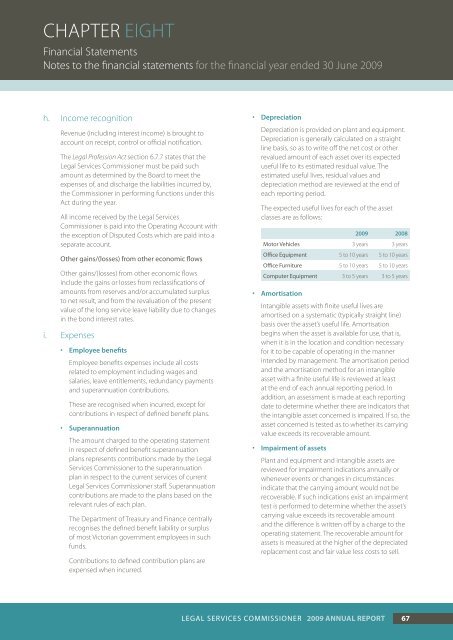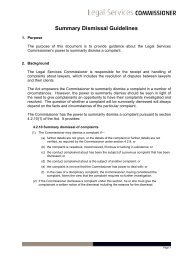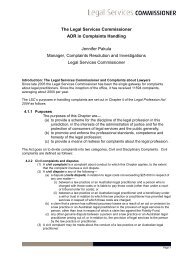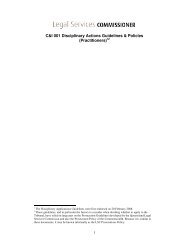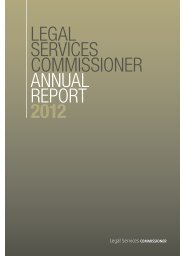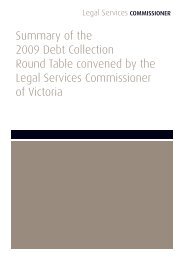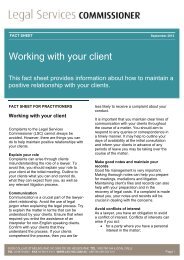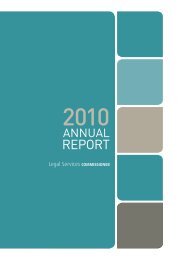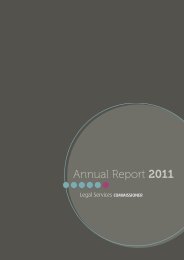Annual Report 2008-09 - Legal Services Commissioner
Annual Report 2008-09 - Legal Services Commissioner
Annual Report 2008-09 - Legal Services Commissioner
Create successful ePaper yourself
Turn your PDF publications into a flip-book with our unique Google optimized e-Paper software.
Chapter EIGHT<br />
Financial Statements<br />
Notes to the financial statements for the financial year ended 30 June 20<strong>09</strong><br />
h. Income recognition<br />
Revenue (including interest income) is brought to<br />
account on receipt, control or official notification.<br />
The <strong>Legal</strong> Profession Act section 6.7.7 states that the<br />
<strong>Legal</strong> <strong>Services</strong> <strong>Commissioner</strong> must be paid such<br />
amount as determined by the Board to meet the<br />
expenses of, and discharge the liabilities incurred by,<br />
the <strong>Commissioner</strong> in performing functions under this<br />
Act during the year.<br />
All income received by the <strong>Legal</strong> <strong>Services</strong><br />
<strong>Commissioner</strong> is paid into the Operating Account with<br />
the exception of Disputed Costs which are paid into a<br />
separate account.<br />
Other gains/(losses) from other economic flows<br />
Other gains/(losses) from other economic flows<br />
include the gains or losses from reclassifications of<br />
amounts from reserves and/or accumulated surplus<br />
to net result, and from the revaluation of the present<br />
value of the long service leave liability due to changes<br />
in the bond interest rates.<br />
i. Expenses<br />
• Employee benefits<br />
Employee benefits expenses include all costs<br />
related to employment including wages and<br />
salaries, leave entitlements, redundancy payments<br />
and superannuation contributions.<br />
These are recognised when incurred, except for<br />
contributions in respect of defined benefit plans.<br />
• Superannuation<br />
The amount charged to the operating statement<br />
in respect of defined benefit superannuation<br />
plans represents contributions made by the <strong>Legal</strong><br />
<strong>Services</strong> <strong>Commissioner</strong> to the superannuation<br />
plan in respect to the current services of current<br />
<strong>Legal</strong> <strong>Services</strong> <strong>Commissioner</strong> staff. Superannuation<br />
contributions are made to the plans based on the<br />
relevant rules of each plan.<br />
The Department of Treasury and Finance centrally<br />
recognises the defined benefit liability or surplus<br />
of most Victorian government employees in such<br />
funds.<br />
Contributions to defined contribution plans are<br />
expensed when incurred.<br />
• Depreciation<br />
Depreciation is provided on plant and equipment.<br />
Depreciation is generally calculated on a straight<br />
line basis, so as to write off the net cost or other<br />
revalued amount of each asset over its expected<br />
useful life to its estimated residual value. The<br />
estimated useful lives, residual values and<br />
depreciation method are reviewed at the end of<br />
each reporting period.<br />
The expected useful lives for each of the asset<br />
classes are as follows:<br />
20<strong>09</strong> <strong>2008</strong><br />
Motor Vehicles 3 years 3 years<br />
Office Equipment 5 to 10 years 5 to 10 years<br />
Office Furniture 5 to 10 years 5 to 10 years<br />
Computer Equipment 3 to 5 years 3 to 5 years<br />
• Amortisation<br />
Intangible assets with finite useful lives are<br />
amortised on a systematic (typically straight line)<br />
basis over the asset’s useful life. Amortisation<br />
begins when the asset is available for use, that is,<br />
when it is in the location and condition necessary<br />
for it to be capable of operating in the manner<br />
intended by management. The amortisation period<br />
and the amortisation method for an intangible<br />
asset with a finite useful life is reviewed at least<br />
at the end of each annual reporting period. In<br />
addition, an assessment is made at each reporting<br />
date to determine whether there are indicators that<br />
the intangible asset concerned is impaired. If so, the<br />
asset concerned is tested as to whether its carrying<br />
value exceeds its recoverable amount.<br />
• Impairment of assets<br />
Plant and equipment and intangible assets are<br />
reviewed for impairment indications annually or<br />
whenever events or changes in circumstances<br />
indicate that the carrying amount would not be<br />
recoverable. If such indications exist an impairment<br />
test is performed to determine whether the asset’s<br />
carrying value exceeds its recoverable amount<br />
and the difference is written off by a charge to the<br />
operating statement. The recoverable amount for<br />
assets is measured at the higher of the depreciated<br />
replacement cost and fair value less costs to sell.<br />
<strong>Legal</strong> <strong>Services</strong> COMMISSIONER 20<strong>09</strong> <strong>Annual</strong> <strong>Report</strong> 67


